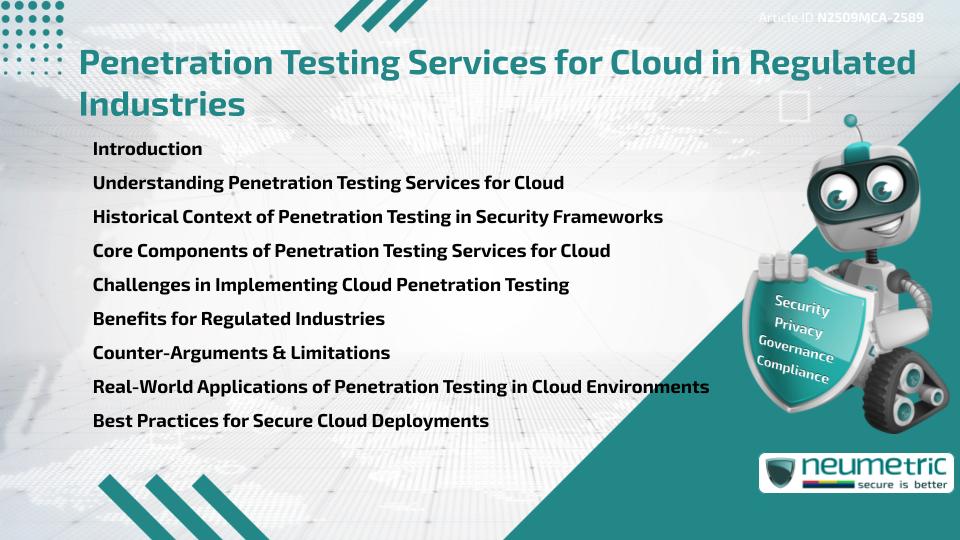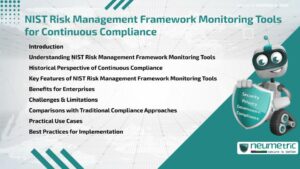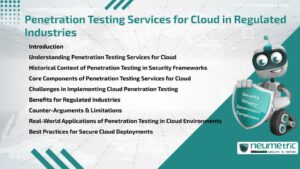Table of Contents
ToggleIntroduction
Penetration Testing Services for Cloud play a crucial role in ensuring regulated industries remain secure & compliant. These Services simulate real-world attacks to identify Vulnerabilities in Cloud Infrastructure, Applications & Configurations. For industries like Healthcare, Finance & Government, Penetration Testing is not just a best practice but often a Regulatory requirement. Without it, Organisations Risk breaches, Compliance failures & reputational damage. This article explores Penetration Testing Services for Cloud, their history, components, challenges, benefits, limitations & Best Practices for regulated industries.
Understanding Penetration Testing Services for Cloud
Penetration Testing Services for Cloud involve authorised simulations of cyberattacks on Cloud environments to evaluate their Security posture. These tests go beyond automated scans by using Ethical Hackers to exploit Vulnerabilities & uncover hidden weaknesses. The results are documented in detailed reports that guide remediation & serve as Evidence during Audits. Just as a fire drill tests building safety, Penetration Testing tests Cloud resilience against Potential Threats.
Historical Context of Penetration Testing in Security Frameworks
Penetration Testing began in the 1990s as Organisations sought to identify weaknesses in their growing digital infrastructures. Early efforts focused on networks & applications, but as Cloud computing expanded, Penetration Testing adapted to virtualised environments. Regulatory frameworks like PCI DSS, HIPAA & ISO 27001 started to include Penetration Testing as a Compliance requirement. The rise of high-profile breaches caused by misconfigured Cloud Services reinforced the importance of Penetration Testing Services for Cloud, making them central to regulated industries.
Core Components of Penetration Testing Services for Cloud
Comprehensive Cloud Penetration Testing includes several key components:
- Reconnaissance: Gathering information on Cloud assets & Services.
- Vulnerability Scanning: Identifying flaws in applications, networks & configurations.
- Exploitation: Attempting to exploit Vulnerabilities to assess impact.
- Post-Exploitation Analysis: Evaluating persistence & data access Risks.
- Reporting: Delivering findings with severity levels & remediation steps.
- Compliance Mapping: Aligning test results with applicable regulations.
Together, these components create a thorough view of an organisation’s Cloud Security posture.
Challenges in Implementing Cloud Penetration Testing
Despite its importance, Penetration Testing Services for Cloud face several challenges. Cloud environments are dynamic, with resources frequently scaling up or down, making consistent testing complex. Shared responsibility models between Cloud providers & Customers create ambiguity about testing scope. Legal & Contractual restrictions sometimes limit Penetration Testing on Third Party infrastructure. Finally, cost & expertise can be barriers, particularly for small & mid-sized Organisations.
Benefits for Regulated Industries
For regulated industries, Penetration Testing Services for Cloud provide significant advantages. They help demonstrate Compliance with laws & standards such as HIPAA, PCI DSS & GDPR. By identifying Vulnerabilities before attackers exploit them, Penetration Testing reduces Risk & strengthens Resilience. It also reassures Stakeholders that the organisation prioritises Security. Just as regular health checkups prevent medical crises, Penetration Testing prevents Cloud Security Incidents from escalating into major breaches.
Counter-Arguments & Limitations
Some critics argue that Penetration Testing is expensive, time-consuming & disruptive to operations. Others highlight that results represent only a snapshot in time & cannot predict future Threats. While these points are valid, the Risks of avoiding Penetration Testing are far greater. Without it, Vulnerabilities may go undetected, leaving Organisations exposed during Compliance Audits or real-world attacks.
Real-World Applications of Penetration Testing in Cloud Environments
Penetration Testing Services for Cloud are widely applied across regulated industries. In Healthcare, they ensure Patient Data Confidentiality & HIPAA Compliance. In Finance, they protect Sensitive Customer transactions & support PCI DSS Audits. Government agencies use Penetration Testing to Safeguard classified systems & ensure Accountability. Technology companies rely on it to protect Intellectual Property hosted in Cloud environments. Across all these industries, Penetration Testing bridges the gap between Compliance obligations & Operational Security.
Best Practices for Secure Cloud Deployments
To maximise the effectiveness of Penetration Testing Services for Cloud, Organisations should:
- Define clear testing scope with Cloud providers.
- Conduct regular tests, especially after major changes.
- Combine automated & manual testing methods.
- Map findings directly to Compliance frameworks.
- Ensure remediation steps are tracked & verified.
- Maintain collaboration between IT, Security teams & Auditors.
By embedding these practices, Organisations can achieve resilient, compliant & secure Cloud deployments.
Conclusion
Penetration Testing Services for Cloud are indispensable for regulated industries. They uncover Vulnerabilities, support Compliance efforts & strengthen Trust with Stakeholders. While challenges & limitations exist, the benefits of proactive testing far outweigh the drawbacks. For industries where Compliance is critical, Penetration Testing is both a necessity & a strategic advantage.
Takeaways
- Penetration Testing Services for Cloud identify Vulnerabilities & support Compliance.
- Core components include Reconnaissance, Scanning, Exploitation & Reporting.
- Challenges include dynamic environments, shared responsibility & cost.
- Benefits include improved Compliance, Resilience & Stakeholder Trust.
- Best Practices ensure testing is effective, consistent & Audit-ready.
FAQ
What are Penetration Testing Services for Cloud?
They are authorised simulations of cyberattacks on Cloud environments designed to identify Vulnerabilities & assess Security posture.
Why are Penetration Testing Services for Cloud important in regulated industries?
They help Organisations comply with regulations, protect Sensitive Data & strengthen resilience against Cyber Threats.
What does a typical Cloud Penetration Test include?
It includes reconnaissance, Vulnerability scanning, Exploitation, Reporting & Compliance mapping.
What challenges exist in Penetration Testing for Cloud?
Challenges include scope definition, shared responsibility, cost, legal restrictions & the dynamic nature of Cloud systems.
Do Penetration Testing Services for Cloud guarantee Compliance?
No, but they provide strong Evidence of proactive security efforts that support Compliance Audits.
How often should Organisations perform Cloud Penetration Testing?
Regularly & especially after significant changes to Cloud infrastructure, Applications or Configurations.
Which industries benefit most from Penetration Testing Services for Cloud?
Healthcare, Finance, Government & Technology sectors benefit significantly due to their Regulatory & Operational requirements.
Need help for Security, Privacy, Governance & VAPT?
Neumetric provides organisations the necessary help to achieve their Cybersecurity, Compliance, Governance, Privacy, Certifications & Pentesting needs.
Organisations & Businesses, specifically those which provide SaaS & AI Solutions in the Fintech, BFSI & other regulated sectors, usually need a Cybersecurity Partner for meeting & maintaining the ongoing Security & Privacy needs & requirements of their Enterprise Clients & Privacy conscious Customers.
SOC 2, ISO 27001, ISO 42001, NIST, HIPAA, HECVAT, EU GDPR are some of the Frameworks that are served by Fusion – a SaaS, multimodular, multitenant, centralised, automated, Cybersecurity & Compliance Management system.
Neumetric also provides Expert Services for technical security which covers VAPT for Web Applications, APIs, iOS & Android Mobile Apps, Security Testing for AWS & other Cloud Environments & Cloud Infrastructure & other similar scopes.
Reach out to us by Email or filling out the Contact Form…





